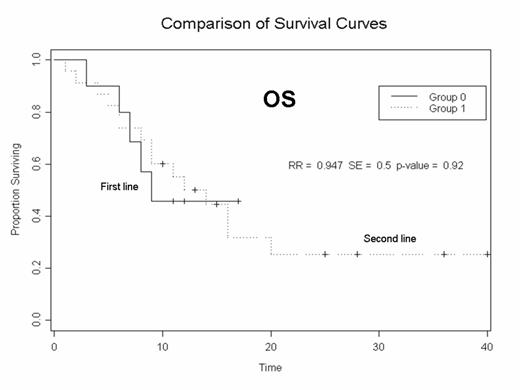Abstract
Bortezomib is a targeted proteosome inhibitor licensed & approved for in multiple myeloma both as first line and in relapsed setting. This is a retrospective non experimental cross sectional quantitative comparative group study using clinical case notes, laboratory & pharmacy records for patients treated with Bortezomib in 2011 & 2012. Outcomes studied included remission status, adverse events, progression free survival and overall survival at follow up. The study also looked at the comparative responses of cohort of patients administered Bortezomib through intravenous & subcutaneous route.
The cohort consisted of 33 patients, 21 male, 11 female, median age 71 years, first line 10 patients, second line 23 , median number of cycles in 2011 & 2012 – first line 3 & 8 , second line 5 & 4, respectively. In 2011, 8 received intravenous treatment, 9 were switched from intravenous to subcutaneous route whilst all patients from 2012 received subcutaneous Bortezomib. The most frequently used regimen was Bortezomib Dexamethasone ( VD).
The overall response rate ( ORR >/= Minor Response) was: First line 70% (7/10) ; Second line 47.8% ( 11/23); median PFS ( Figure 1) 6 months ( First line: 7 months ; Second line : 6 months) and median overall survival ( Figure 2) at follow up: 9 months ; 39.4 % ( 13/33) First line 8.5 months, Second line 11 months. Subcutaneous Bortezomib was equivalent to intravenous Bortezomib in terms of efficacy & tolerance.
Of 33 patients, there were 12 dose reductions. Adverse events reported included:
peripheral Neuropathy - grade 3 - 6% ( all grades 27.3%); Diarrhoea - grade 3 - 3%
(all grades 6%); Nausea / Vomiting - grade 3 - 3% ( all grades 6%) and Second Primary Malignancies - 12% ( 4 of 33). Mortality at follow up was 20 patients from cohort of 33 ; causes included disease progression in 11, second primary malignancy with disease progression in 4, COPD 2, Systemic Amyloidosis 2, Tuberculosis 1 , Multiple co morbidities 1 and Asthma with mechanical failure in single patient. Second primary malignancies ( 4/33) included Prostate carcinoma ( 1), Renal Cell Carcinoma (1), Neuroendocrine tumour ( 1 ) and Unknown Primary in single patient. Beyond second line treatment, majority (14 of 23 patients; 60.9 %) did not have further active treatment.
These data indicate that patient outcomes were modest compared to published data from VISTA and APEX trials. Majority of patients did not have further active treatment beyond second line which suggests the most effective treatment strategy should be used upfront as patients may not be fit to have further lines of therapy despite availability of recently introduced novel targeted agents. A higher percentage of second primary malignancies were noticed in this cohort which should be an area of further clinical research.
Progression free survival with Bortezomib as first line & second line in multiple myeloma
Progression free survival with Bortezomib as first line & second line in multiple myeloma
Overall survival with Bortezomib as first line & second line in multiple myeloma
Overall survival with Bortezomib as first line & second line in multiple myeloma
No relevant conflicts of interest to declare.
Author notes
Asterisk with author names denotes non-ASH members.



